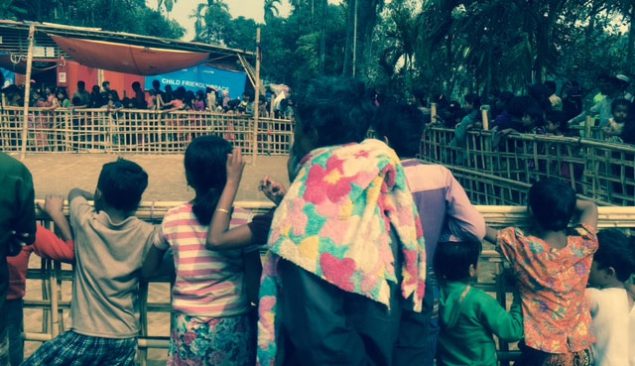Vaccination Research for Action
Vaccination Coverage Among Displaced Rohingyas in Bangladesh

A Rohingya gathering. Credit: Mohamed Jalloh.
From November 2017 through January 2018, more than 4,000 suspected cases of diphtheria and 30 diphtheria-related deaths were reported among displaced Rohingya refugees in Cox’s Bazar District, Bangladesh. In January 2018, CDC conducted a qualitative assessment to understand vaccination barriers and opportunities to enhance vaccine demand among refugees. The assessment consisted of focus group discussions and key informant interviews with mothers and fathers who had children under 5 years old, community volunteers, majhis (camp leaders), Islamic religious leaders, traditional and spiritual healers, and teachers. Although participants understood vaccination as an important intervention to prevent childhood diseases, they reported numerous barriers to vaccination, including concerns about multiple vaccines given on the same day, worries about vaccination side effects, and lack of sensitivity to cultural gender norms at vaccination sites. Vaccine demand and acceptance were enhanced by improving vaccine delivery practices and engaging community leaders to address religious and cultural barriers.
Innovations in Fractional Dose of Yellow Fever Vaccine
Because of the increased use of and demand for yellow fever (YF) vaccine, global stockpiles have been depleted. Therefore, in 2016, WHO issued a new recommendation that a fractional (1/5) YF vaccine (fYF) dose could be used for outbreak response when there is a shortage of vaccine, based on limited evidence available from clinical trials in adults. However, WHO identified an urgent need to compile immunogenicity data for fYF in children and infants. In response to this request, CDC initiated two fYF immunogenicity studies; the findings of one of these studies conducted in the Democratic Republic of the Congo was published in 2018. The fractional dose was shown to be highly effective at providing protective immunity for at least 1 year in people at least 2 years old and was particularly effective in generating an immune response in those with low levels of or no preexisting antibodies. This was the first study of fYF vaccination to include children and is critical to informing global yellow fever vaccination policy. Planning and training has been completed for a second study to evaluate fYF immunogenicity in children under 2 years old in Uganda, and enrollment began in March 2019.
The Promise of an Experimental Malaria Vaccine
In 2017, 219 million cases of malaria and 435,000 related deaths occurred worldwide, many of them in children under 5 years of age in sub-Saharan Africa. Working to help expand available interventions, CDC has continued to evaluate promising new vaccines and, in 2018, collaborated with the National Institutes of Health, Sanaria, and other partners to evaluate the safety of and response to an experimental malaria vaccine (PfSPZ) in young children. Data collection and analysis were completed, and reporting is underway. In addition, in 2018 CDC and a consortium of partners were selected to lead an evaluation of pilot implementation of another malaria vaccine (RTS,S/AS01) in western Kenya. This activity provides additional critical information about feasibility, impact, and safety of this vaccine.